Mastering the Keltner Bands trading strategy involves combining Keltner Channels with a 20-period EMA to analyze price movements, spot potential breakouts, gauge market volatility, and implement sound risk management. By understanding band width, breakout signals, and volatility impact, traders can make informed decisions. Incorporating robust risk management strategies, combining Keltner Channels with other indicators, and utilizing effective combination strategies further enhance trading outcomes. Exploring Keltner Channel formula calculation, signal utilization, and comparisons with Bollinger Bands offer deeper insights into market dynamics. This meticulous approach provides traders with a structured method to optimize their trading performance.
Understanding Keltner Channels Calculation
In the domain of technical analysis, a vital aspect to grasp is the precise calculation method behind Keltner Channels, which involves utilizing a 20-period Exponential Moving Average (EMA) as the central reference line.
Keltner Channels are a popular indicator used in trading channels to assess volatility and potential price breakouts. The upper and lower bands of the Keltner Channel are determined by adding or subtracting twice the Average True Range (ATR) from the EMA.
ATR is an essential component in this calculation as it measures price volatility based on specific price differentials. It considers the largest value among the current high minus the current low, the absolute value of the current high minus the previous close, and the absolute value of the current low minus the previous close.
The combination of the EMA, upper band, and lower band forms the Keltner Channel, providing traders with valuable insights into potential price movements and volatility in the market.
Interpreting Price Movements Within Bands
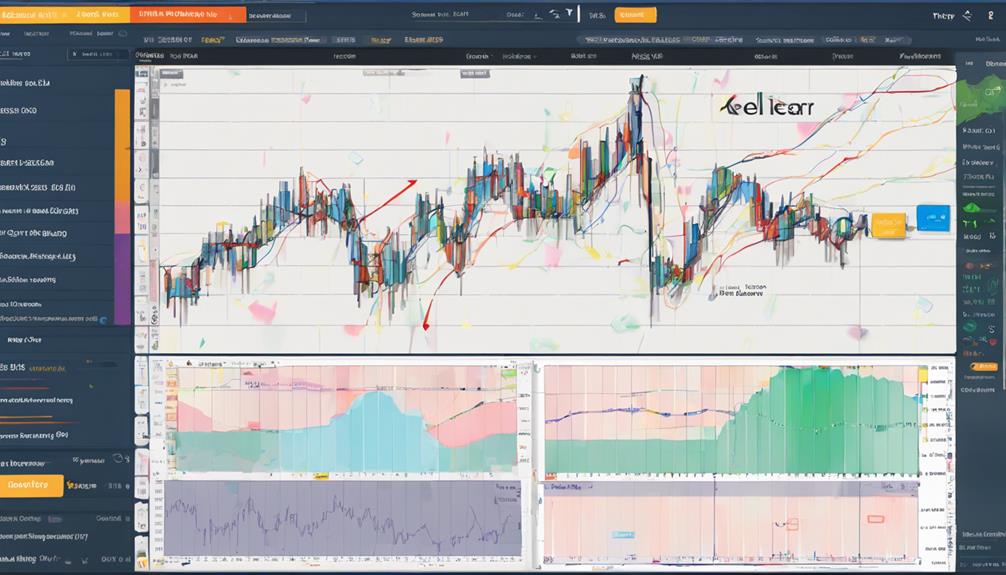
Analyzing price movements within Keltner Bands involves understanding the significance of band width. Recognizing signals of potential breakouts is crucial in identifying new trading opportunities. Evaluating the impact of volatility on market dynamics helps traders anticipate potential price movements.
Traders can leverage these insights to interpret whether price action indicates a period of consolidation, a potential trend continuation, or the onset of a new market direction. By closely monitoring how prices interact with the bands, traders can gain valuable insights into market sentiment and make informed trading decisions.
Band Width Significance
Band width, a key metric in Keltner Bands trading strategy, serves as an important indicator of market volatility by measuring the distance between the upper and lower bands. Traders analyze band width changes to gauge market conditions, anticipate potential price movements, and adapt their trading strategies accordingly. A narrowing band width suggests decreased volatility, often leading to price consolidation, while a widening band width indicates escalating market volatility and potential price breakouts. Monitoring band width fluctuations is crucial for determining the best entry and exit points in trading. The table below illustrates the relationship between band width, market volatility, and price movements:
| Band Width | Market Volatility | Price Movements |
|---|---|---|
| Narrowing | Decreased | Consolidation |
| Widening | Increasing | Breakouts |
Price Breakout Signals
Regularly observing price movements within the Keltner Bands allows traders to identify significant breakout signals indicative of potential trend shifts or continuations.
Price breakout signals occur when the price moves outside the Keltner Channel bands, signaling possible trend reversals or continuations. To confirm these breakouts, traders look for increased volume, as it enhances the validity of the signals.
Proper risk management is essential when trading breakouts; setting stop-loss and take-profit levels based on breakout signals helps mitigate potential losses and maximize profits.
Volatility Impact Analysis
Observing price movements within the Keltner Bands offers valuable insights into the impact of volatility on market dynamics and trend strength. By analyzing how prices interact with the bands, traders can interpret market sentiment and assess the strength of prevailing trends. The table below illustrates the relationship between price movements within the bands and their implications for market behavior:
| Price Movement | Volatility Impact | Market Sentiment |
|---|---|---|
| Prices touch upper band | High volatility, possible overbought conditions | Bullish sentiment |
| Prices touch lower band | High volatility, potential oversold conditions | Bearish sentiment |
| Prices trade within bands | Low to moderate volatility, consolidation phase | Neutral sentiment |
This analysis aids in identifying potential breakout or reversal points, guiding traders in making informed decisions based on market dynamics and trend strength.
Effective Utilization of Keltner Indicator
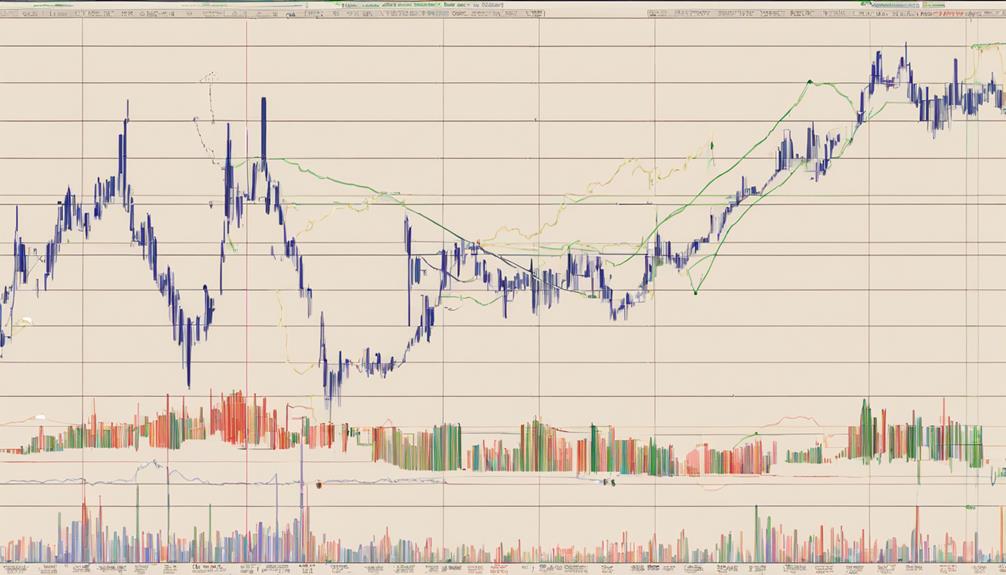
Implementing a structured approach to interpreting the signals generated by the Keltner Indicator enhances trading decision-making effectiveness.
The Keltner Indicator, utilizing Keltner Channels based on average true range (ATR) calculations, provides traders with valuable insights into price action dynamics.
By incorporating the indicator into a trading strategy, traders can effectively identify potential breakouts and trend reversals, allowing for timely entry and exit points.
The Keltner Indicator serves as a tool for setting stop-loss and take-profit levels, enabling traders to manage risk efficiently.
Traders can utilize the indicator in breakout strategies to capitalize on significant price movements and in trend identification to align trades with the prevailing market direction.
Understanding the nuances of the Keltner Indicator and its relationship with price volatility is essential for maximizing its effectiveness in trading decisions.
Importance of Backtesting for Traders

Backtesting is an essential component in a trader's toolkit, providing a systematic approach to evaluating trading strategies using historical data.
By simulating trades based on past market conditions, traders can gain insights into how a strategy would have fared in different scenarios.
This process aids in refining strategies, optimizing parameters, and ultimately enhancing the overall effectiveness of trading approaches.
Backtesting for Trading
Conducting thorough backtesting of trading strategies is essential for traders seeking to validate the reliability and robustness of their approaches through historical data analysis. Backtesting allows traders to evaluate how their trading strategies would have performed under different market conditions, helping in the optimization of strategies based on past results. By identifying strengths, weaknesses, and areas for improvement, traders can enhance their strategies before implementing them in live markets. Proper backtesting increases confidence in a trading strategy and provides valuable insights into its potential success. The table below outlines the key benefits of backtesting for traders:
| Benefits of Backtesting |
|---|
| Evaluate strategy performance under different market conditions |
| Refine and optimize trading strategies based on historical data |
| Identify strengths, weaknesses, and areas for improvement |
| Increase confidence in trading strategies before live market implementation |
| Gain valuable insights for potential strategy success |
Testing Trading Strategies
Evaluating the effectiveness of trading strategies through meticulous backtesting using historical data is an essential step for traders aiming to enhance their decision-making processes and optimize their approaches. Backtesting allows traders to analyze how their strategies would have performed in the past under various market conditions.
By testing strategies on historical data, traders can identify potential flaws and weaknesses before risking real capital. This process provides valuable insights into a strategy's performance and helps traders fine-tune their approaches for improved profitability.
Consistent backtesting is important for building confidence in a trading strategy and making well-informed decisions based on data-driven analysis. By rigorously testing trading strategies, traders can adapt to changing market dynamics and increase their chances of success.
Risk Management Strategies in Trading
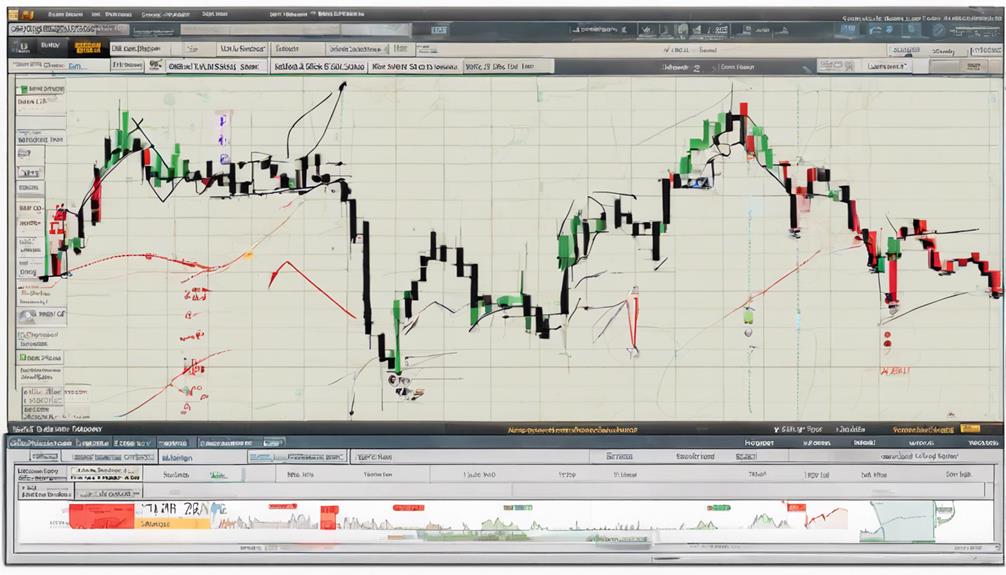
When engaging in trading, successful investors prioritize the implementation of robust risk management strategies to safeguard their capital and optimize their trading performance. Utilizing Keltner Bands as part of a trading strategy requires a keen focus on risk management.
Implementing stop-loss orders is important to limit potential losses and protect capital when trading with Keltner Bands. Additionally, employing effective position sizing techniques helps manage risk exposure and ensures that no single trade heavily impacts the overall portfolio.
Diversification is another key aspect of risk management, spreading investments across different assets to reduce overall risk. Before entering any trade using Keltner Bands, it is essential to evaluate the risk-to-reward ratio to make informed decisions.
Regularly reviewing and adjusting risk management strategies based on market conditions and performance is crucial for long-term success in trading with Keltner Bands. By incorporating these risk management practices, traders can enhance their chances of success while using the Keltner Bands trading strategy.
Combining Keltner Channels With Other Indicators
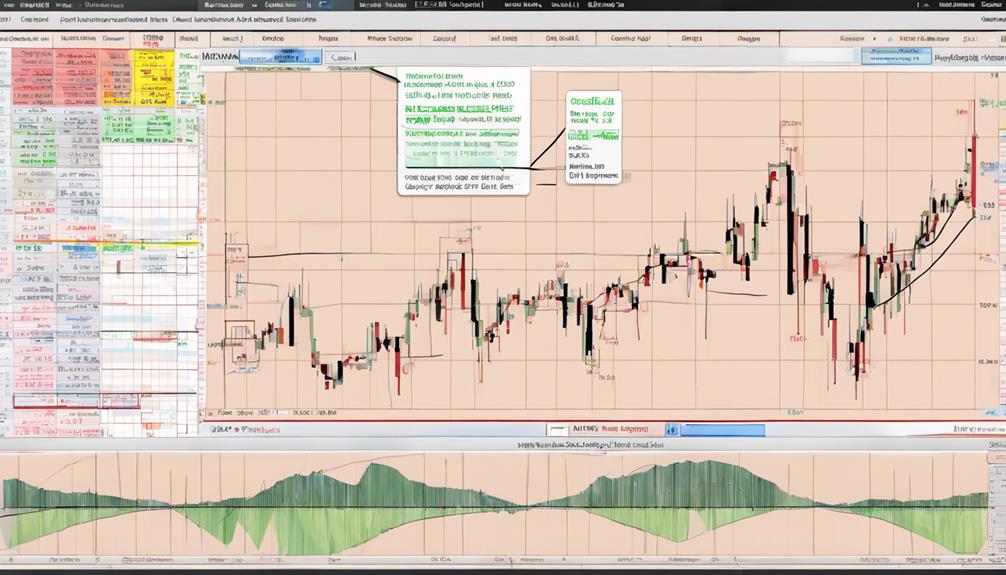
Integrating Keltner Channels with various technical indicators can offer traders a holistic view of market dynamics and potential opportunities. By combining these indicators strategically, traders can enhance their decision-making process and potentially increase the accuracy of their trading signals.
Maximizing the synergy between Keltner Channels and other indicators can lead to more effective trend analysis and better risk management strategies.
Indicator Synergy Tips
To enhance trading precision and signal strength, practitioners often amalgamate Keltner Channels with various technical indicators. When combining Keltner Channels with moving averages, traders can confirm trend direction effectively. Using indicators like RSI or Stochastic Oscillator alongside Keltner Channels helps in identifying overbought or oversold conditions. Pairing Keltner Channels with MACD can assist in spotting potential trend reversals. Additionally, incorporating Fibonacci retracement levels with Keltner Channels aids in pinpointing key support and resistance areas. Additionally, utilizing volume indicators in conjunction with Keltner Channels can provide valuable confirmation signals for breakout trading strategies. The table below summarizes the synergies between Keltner Channels and other indicators:
| Indicator Combination | Purpose | Strategy Used |
|---|---|---|
| Moving Averages | Confirming trend direction | Trend confirmation strategy |
| RSI or Stochastic | Identifying overbought/oversold signals | Reversal signal strategy |
| MACD | Spotting potential trend reversals | Trend reversal strategy |
| Fibonacci Retracement | Pinpointing key support/resistance areas | Support/resistance strategy |
| Volume Indicator | Confirming breakout signals | Breakout confirmation strategy |
Effective Combination Strategies
An essential aspect of optimizing trading strategies involves strategically combining Keltner Channels with other indicators to enhance decision-making processes and increase the accuracy of trade signals.
Traders can combine Keltner Channels with Moving Averages to confirm trend direction and filter out false signals effectively. Additionally, integrating Relative Strength Index (RSI) along with Keltner Channels helps validate overbought or oversold conditions.
Utilizing Volume indicators in conjunction with Keltner Channels can confirm breakout signals identified, leading to higher probability trades. Furthermore, pairing Keltner Channels with Fibonacci retracement levels aids in identifying potential reversal points within the trend.
Another beneficial approach is integrating MACD to provide further confirmation of trend strength when trading with Keltner Channels.
Maximizing Signal Strength
Maximizing signal strength through the strategic combination of Keltner Channels with other indicators is a holistic approach in enhancing trading precision and decision-making effectiveness. By integrating different indicators, traders can gain a more thorough view of the market dynamics and improve the accuracy of their trading signals. One effective way to maximize signal strength is by combining Keltner Channels with other tools such as moving averages like the 50-period SMA for trend confirmation, the RSI for identifying overbought and oversold conditions, and the MACD indicator for detecting momentum shifts. Additionally, incorporating Fibonacci retracement levels can help pinpoint potential price reversal points with greater precision. The table below illustrates how combining Keltner Channels with these indicators can enhance trading strategies:
| Indicator | Purpose | Benefit |
|---|---|---|
| Moving Averages | Trend Confirmation | Enhanced Signal Accuracy |
| Relative Strength Index | Overbought and Oversold Validation | Improved Entry/Exit Points |
| MACD Indicator | Momentum Shifts and Reversals | Insights into Trend Changes |
Trading Breakouts With Keltner Channel
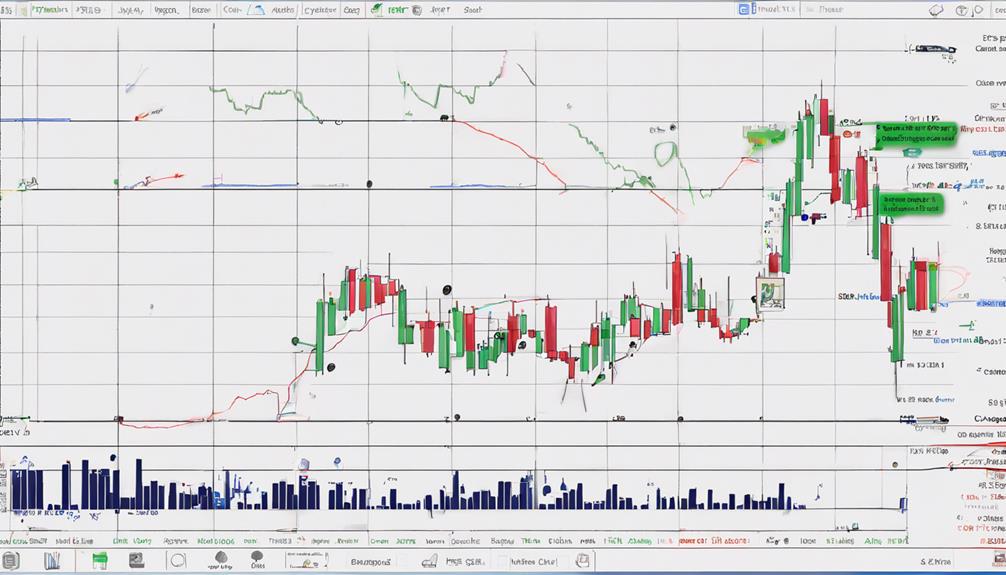
Utilizing the Keltner Channels for breakout trading strategies involves identifying price movements that breach the upper or lower bands of the channel. When trading breakouts with Keltner Channels, certain key points should be considered:
- Breakouts are signaled when price surpasses the upper or lower bands of the Keltner Channels.
- Confirmation of breakouts with an increase in trading volume can enhance the reliability of the trading signal.
- Incorporating Keltner Channels into breakout strategies can help traders capture the momentum of a developing trend.
- Setting appropriate stop-loss levels based on the Keltner Channel boundaries is essential for effective risk management.
Trading Ranging Markets With Keltner Channel
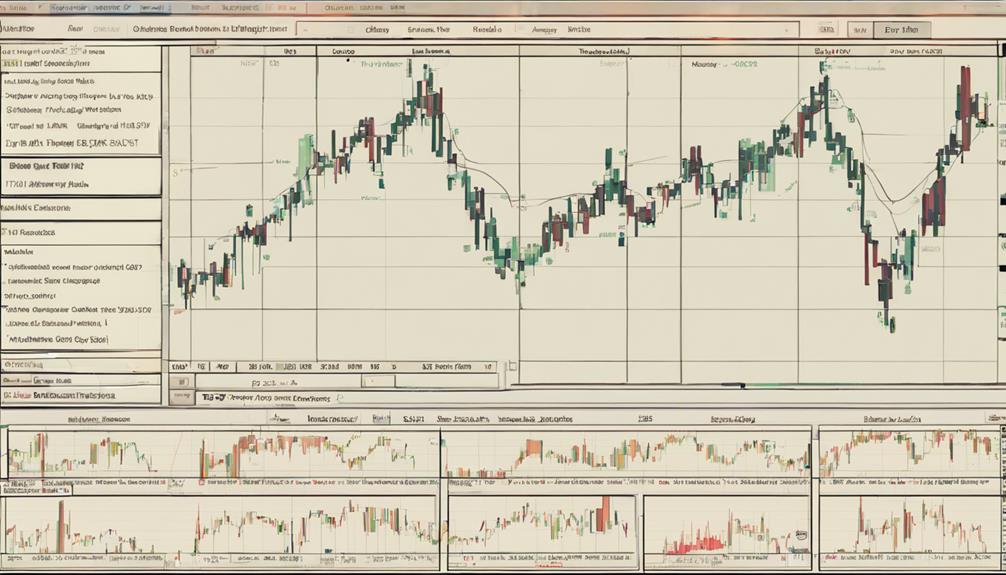
Trading ranging markets with Keltner Channels involves employing range-bound trading strategies that capitalize on the dynamic support and resistance levels provided by the indicator.
Traders can effectively utilize the Keltner Channel system to navigate sideways price movements and identify potential breakout points within the established range.
Recognizing price bounces off the upper and lower bands of the Keltner Channels is essential for making informed trading decisions in ranging markets.
Range-Bound Trading Strategies
In the domain of range-bound trading strategies, leveraging the Keltner Channel to navigate ranging markets proves to be a methodical approach with defined boundaries for trade opportunities.
- Trading strategies with Keltner Channels in range-bound markets focus on capturing price movements within established boundaries.
- Keltner Channels in ranging markets offer clear upper and lower boundaries for potential trades.
- Traders can use Keltner Channels to identify price consolidation and breakouts within range-bound markets.
- Utilizing Keltner Channels in range-bound conditions helps in setting precise entry and exit points.
This approach benefits from Keltner Channel's adaptability to market volatility, making it a valuable tool for traders seeking to capitalize on price movements within a confined range.
Utilizing Keltner Channel
The application of Keltner Channels in maneuvering through ranging markets offers traders a systematic approach to identifying precise entry and exit points within established boundaries. Keltner Channels, with their volatility-based upper and lower boundaries derived from the Average True Range (ATR), are particularly useful in trading ranges.
Traders can capitalize on potential pullback opportunities within the range by utilizing Keltner Channels to pinpoint ideal entry and exit points. The adaptability of Keltner Channels to varying market conditions, especially in sideways markets, makes them valuable tools for traders. By combining Keltner Channels with other indicators, traders can enhance the accuracy of their trading signals and overall performance.
These channels provide dynamic support and resistance levels within the range, empowering traders to make well-informed decisions during ranging market conditions.
Trading Pullbacks With Keltner Channel
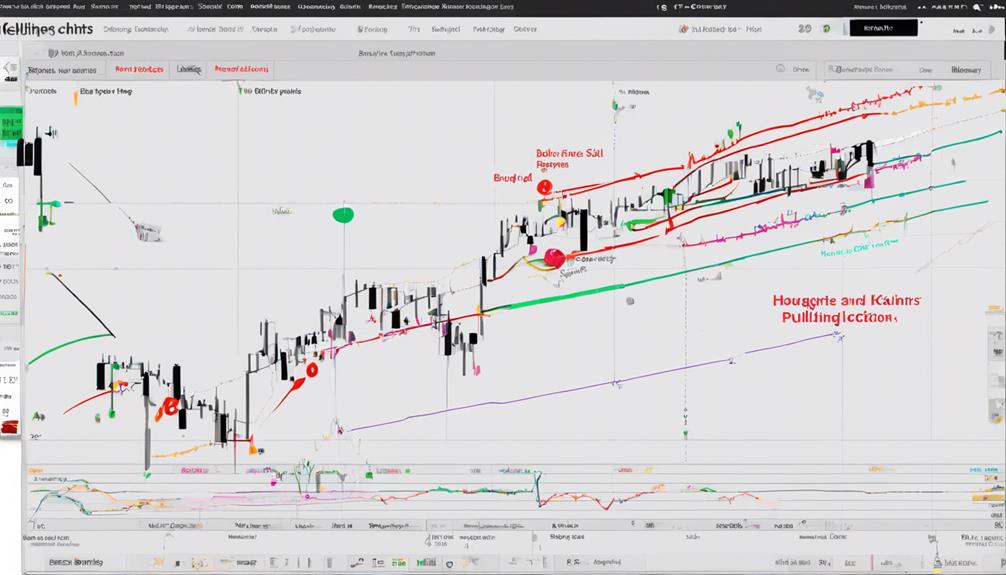
When considering market trends and price retracements within established patterns, utilizing the Keltner Channel's middle line as a pivotal reference point can enhance trading strategies.
Trading pullbacks with Keltner Channel involves identifying price retracements within an established trend and waiting for the price to retrace towards the middle line while considering the trend's strength and market conditions.
To effectively trade pullbacks using the Keltner Channel, traders should utilize the middle line (20-period EMA) as a key level for potential pullback entries.
Additionally, incorporating the Keltner Channel's upper and lower bands as dynamic support and resistance levels can help traders determine strategic entry and exit points for pullback trades.
Proper risk management strategies, such as setting stop-loss orders based on the Keltner Channel's bands, are essential to control losses and protect capital when trading pullbacks with the Keltner Channel.
Keltner Channel Trading System
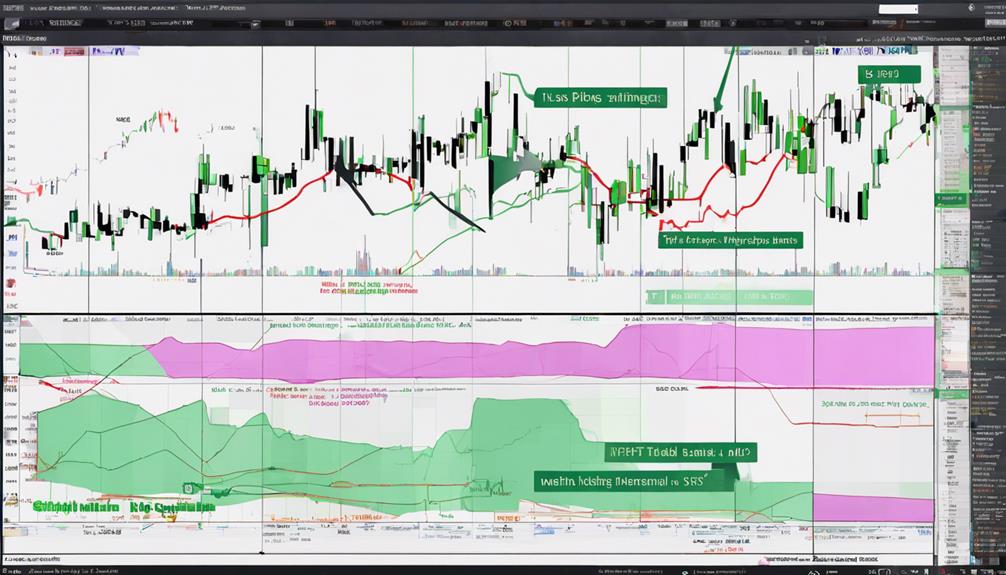
Utilizing the Keltner Channel as a technical indicator facilitates traders in identifying potential breakout points and gauging market volatility for informed trading decisions. The system is composed of three lines: a middle line based on an Exponential Moving Average (EMA) and upper/lower boundaries calculated using the Average True Range (ATR) multiplied by a factor of 2.
Traders can utilize the Keltner Channels to analyze trends, with the middle line acting as a guide for the prevailing price direction. When prices touch the outer boundaries of the channels, it may indicate overbought or oversold conditions, potentially signaling a reversal in the current trend.
This system allows traders to develop various strategies, including trend-following, counter-trend, and breakout approaches. By combining the Keltner Channels with other technical indicators, traders can enhance the accuracy of their trading signals and make more effective decisions in the dynamic financial markets.
Keltner Channel Formula Calculation
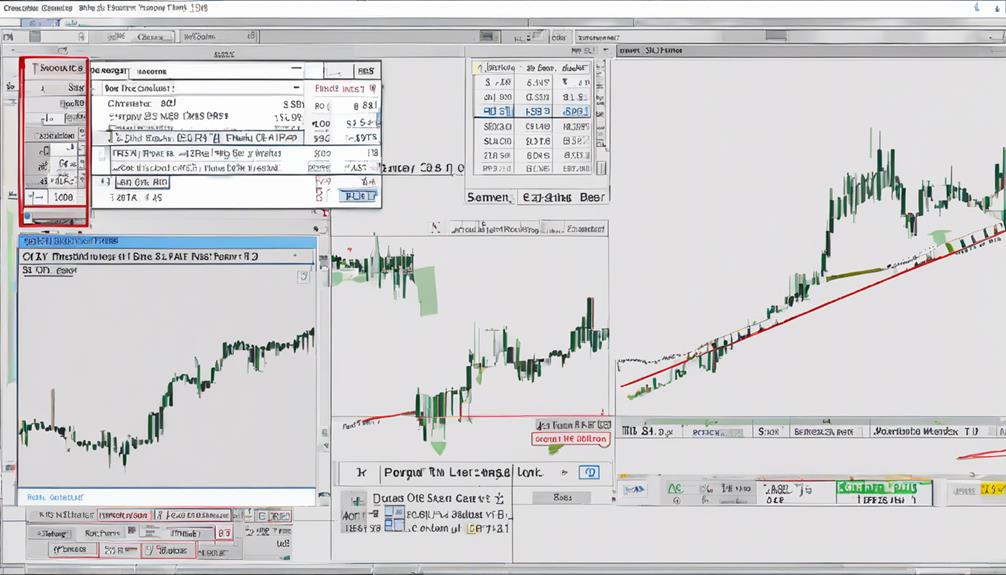
How is the Keltner Channel Formula calculated for identifying potential trading opportunities in the financial markets?
The Keltner Channel calculation involves using a 20-period Exponential Moving Average (EMA) as the middle line. This EMA serves as the baseline for the channel, around which the upper and lower bands are constructed.
Here is a breakdown of the Keltner Channel Formula Calculation:
- Middle Line: 20-period EMA.
- Upper Band: Middle line + (2 times the Average True Range (ATR)).
- Lower Band: Middle line – (2 times the ATR).
- ATR Calculation: Considers the true range of price movements to gauge market volatility levels.
Utilizing Keltner Channel Signals
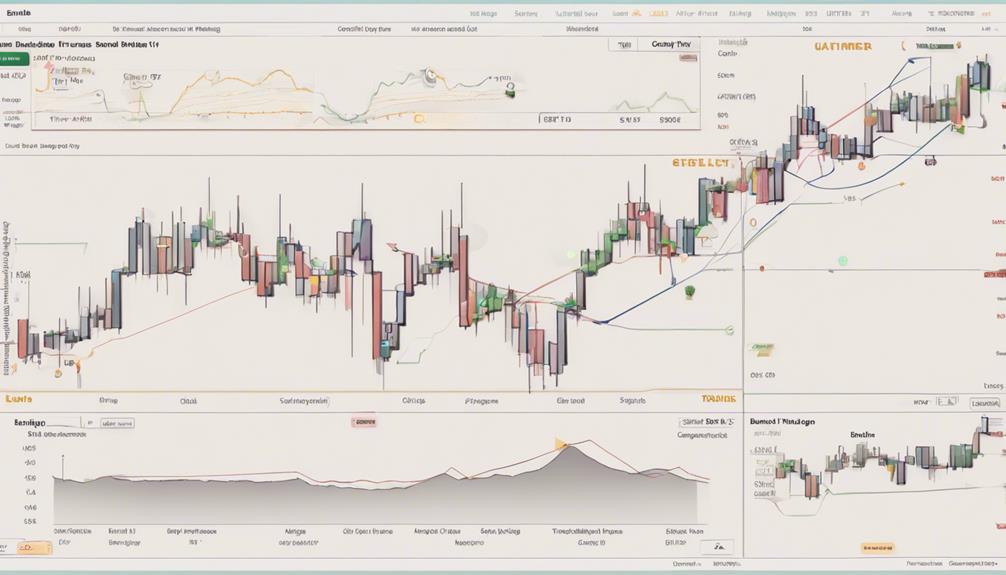
Following the analysis of Keltner Channel Formula Calculation, the efficient utilization of Keltner Channel signals is crucial for making informed trading decisions in the financial markets.
These signals are derived from the interplay between price movements and the upper and lower bands of the channel. Breakouts above the upper band indicate potential buying opportunities, signaling a bullish trend, while breakouts below the lower band suggest potential selling opportunities, indicating a bearish trend.
When the price consolidates within the channel, it signifies a lack of a clear market direction. Traders rely on these volatility-based signals to determine entry and exit points for their trades, adjusting their strategies based on the prevailing market conditions.
It is advisable to use Keltner Channel signals in conjunction with other technical indicators for a thorough analysis. Additionally, setting stop-loss orders based on the channel signals can help manage risk effectively in trading scenarios.
Comparing Keltner Channels Vs. Bollinger Bands
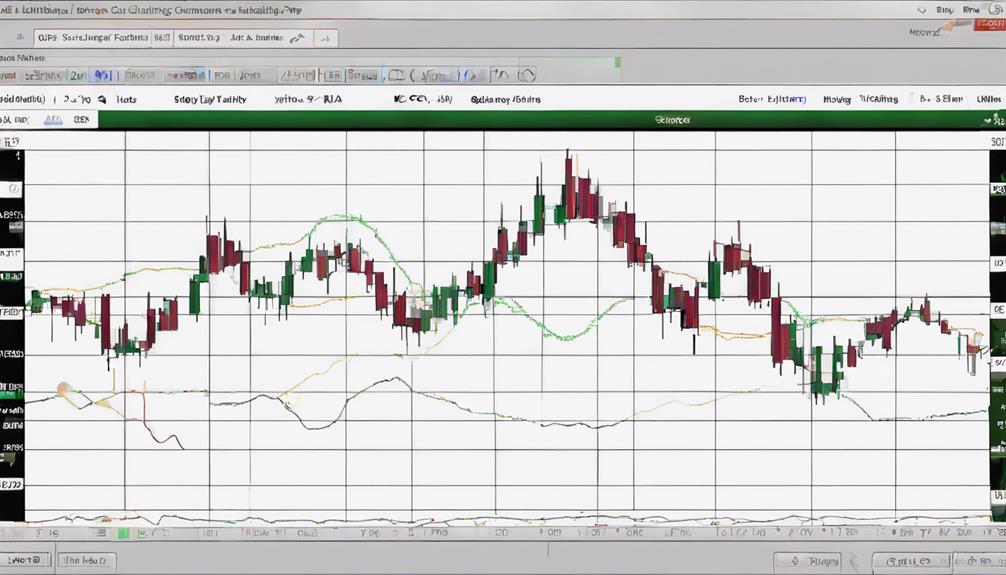
When comparing Keltner Channels and Bollinger Bands, it is essential to understand the distinct methodologies each indicator employs in analyzing market dynamics.
- Keltner Channels use ATR for calculations, while Bollinger Bands use standard deviation.
- Keltner Channels are more sensitive to price movements in trending markets compared to Bollinger Bands.
- Bollinger Bands are based on a fixed standard deviation, while Keltner Channels adjust dynamically based on market volatility.
- Keltner Channels provide clearer signals for trend following strategies, while Bollinger Bands are more versatile for range-bound markets.
The Keltner channel indicator is known for its volatility-based approach, utilizing the Average True Range (ATR) to gauge market conditions. In contrast, Bollinger Bands are popular for their adaptability and are often employed in trend following strategies. Understanding the nuances of these indicators can assist traders in selecting the most suitable tool based on the prevailing market conditions.
Limitations of Keltner Channels Trading
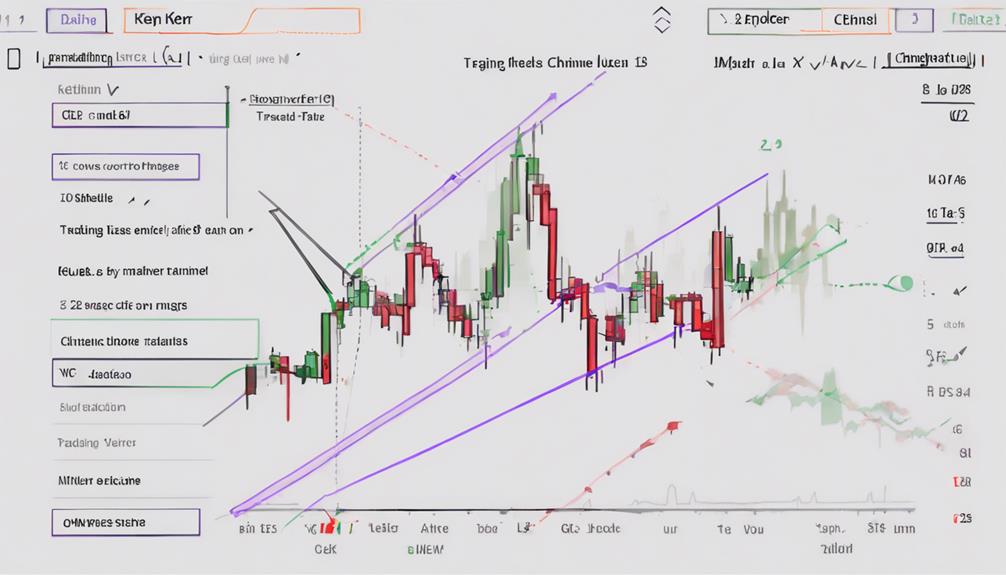
Keltner Channels trading encounters limitations that necessitate a meticulous approach to optimize effectiveness and mitigate risks. While this strategy can be valuable in capturing trends and identifying potential entry and exit points, its efficacy is subject to market dynamics.
In a ranging market, where price movements lack clear direction, Keltner Channels may provide false signals, leading to potential trading losses. To enhance trading success, traders should consider incorporating additional technical analysis tools to complement Keltner Channels' signals. It's essential to practice informed trading by confirming signals generated by the channels with other indicators to validate trade opportunities.
Additionally, traders must exercise proper risk management techniques when utilizing Keltner Channels to avoid significant financial pitfalls. Understanding the practical application of Keltner Channels within the broader market context is essential to navigate its limitations effectively and make well-informed trading decisions.
Frequently Asked Questions
Is Keltner Channel Strategy Profitable?
Profitability analysis of the Keltner Channel strategy reveals varying outcomes based on market conditions, backtesting results, and risk management practices. Success hinges on understanding trading psychology and adapting to market nuances.
When properly utilized, the strategy can prove profitable, especially when combined with complementary indicators. Diligent backtesting and continuous evaluation against changing market dynamics are essential for sustained profitability.
Profit potential is realized through strategic implementation and adherence to risk management principles.
What Is the 5 3 1 Trading Strategy?
The 5 3 1 trading strategy is a popular method that combines trend following and risk management techniques. By using specific settings for Keltner Channels – 5 for EMA period, 3 for ATR multiplier, and 1 for ATR period – traders can identify breakout signals for both scalping opportunities and swing trading.
This strategy offers a structured approach to trading, allowing for efficient decision-making and optimized performance in various market conditions.
What Is the Best Setting for Keltner Channel?
In determining the best setting for the Keltner Channel, traders often seek to find the most suitable parameters that suit their trading style. By customizing settings such as the EMA and ATR lengths, traders can create ideal combinations that align with their strategies.
Backtesting results can offer insights into the effectiveness of different indicator variations. Adapting these parameters can enhance trend identification and confirmation within the channel, leading to more informed trading decisions.
How to Trade Keltner Bands?
When trading Keltner Bands, it is essential to identify entry and exit points based on breakouts or reversals near the bands.
Implementing robust risk management strategies, such as setting stop-loss orders and determining position sizes according to volatility analysis, is vital.
Backtesting results can validate the effectiveness of the chosen approach.
Conclusion
To sum up, mastering the Keltner Bands trading strategy requires a deep understanding of its calculation, interpretation of price movements, effective utilization of the indicator, backtesting, and risk management strategies.
Like a skilled navigator using a compass to navigate through rough seas, traders can use Keltner Channels to guide them through the volatile waters of the financial markets with precision and confidence.
